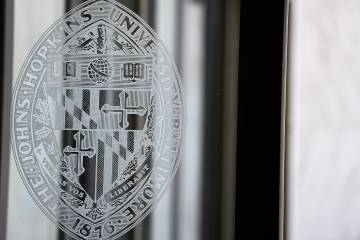Five years ago, Johns Hopkins University launched its Roadmap on Diversity and Inclusion in order to state its commitments in those areas explicitly and in concrete terms. Now the institution is preparing to assess numerous programs and activities across its divisions and develop a set of recommendations for the next five years.
In a message to the university community today, JHU President Ronald J. Daniels and Provost Sunil Kumar wrote, "this work is foundational to our community, and it has taken on ever-greater urgency in these past few months as the nation continues to grapple with the impact of systemic racism and the brutal reality of violence against Black and brown Americans."
They acknowledged the "profound anger and sadness" in the community as the police shooting of Jacob Blake in Kenosha, Wisconsin, became "yet another chapter in a devastating summer of recurring police violence that has unleashed protests across the nation." They added, "It is clear that the anti-racist, equity-seeking, and inclusive values we espouse must continue to guide our capacity to support our community and our efforts to achieve concrete and tangible change in our institution."
The Roadmap 2020 Task Force, announced in July along with several other initiatives, will lead the process of reviewing the Roadmap and setting new goals. Students, faculty, and staff from across university divisions as well as members of the Baltimore community have agreed to serve on the task force; the full roster is on the Diversity and Inclusion website. Three co-chairs—Katrina Caldwell, vice provost and chief diversity officer; Ashley Llorens, chair of the Johns Hopkins Diversity Leadership Council; and Patricia Davidson, dean of the Johns Hopkins School of Nursing—will guide the process, which will include convening theme-based working groups to gather knowledge and surface ideas in a way that promotes broad transparency, includes all voices, and provides opportunities to shape the final recommendations to leadership.
"For the task force to succeed, it must draw upon the perspectives and experiences of a wide-ranging representation of stakeholders from across our institution, including faculty, staff, and students, as well as the broader Baltimore community," Daniels and Kumar said in their message. "We were fortunate to have had significant interest from many people at all levels of our institution."
The task force will commence its work with a retreat, co-sponsored by the Diversity Leadership Council, on Sept. 10 and continue throughout the year. University leadership has asked the task force to produce preliminary recommendations this spring to be shared with the JHU community for input. The final report, which will incorporate community feedback, will be shared with leadership by June with the recommendations shared with the board of trustees for consideration and endorsement. The final report will be released to the community in fall 2021.
The group plans to hold two leadership town halls, one on Sept. 18 at 9 a.m. to kick off the process and one in early 2021 to discuss preliminary recommendations, as well as a series of listening sessions focused on strategic priorities beginning in October and continuing through early 2021. There will be an open comment period before the full report is finalized, and individuals are invited to share ideas, feedback, and insights at any time through a feedback form on the Diversity and Inclusion website.
While the task force is starting its work, the university is releasing its third Roadmap progress report recounting diversity and inclusion efforts across the institution. This regular sharing of data and stories "embodies our belief that systemic change demands an articulation of values accompanied by a clear action plan and the willingness to shine a light on both our accomplishments and the areas in which we have fallen short," Daniels and Kumar said.
Among the highlights:
- A $1.8 billion gift from Michael Bloomberg in 2018 boosted the university's existing upward trajectory in the diversity of the incoming class with the percentage of underrepresented racial minorities (URM) increasing from 14.9% to 32.5% between 2010 and 2019, and the percentage of students eligible for Pell grants increasing from 11.1% to 19.1% in that time
- The university regularly publishes composition reports regarding Johns Hopkins faculty, staff, and graduate students, and the latest editions show there has been growth over several years in the number of female and URM affiliates
- The HopkinsLocal economic inclusion initiative has driven substantial investments in the Baltimore community by focusing on local and minority-owned businesses and city residents when Johns Hopkins University and Johns Hopkins Health System build, hire, and buy
- The loss of university leaders in two key areas—the Office of Institutional Equity and the Office of Diversity and Inclusion—was a setback to the pace and consistency of the university's work last year. However, nationwide searches yielded strong candidates for both positions, both of whom joined Hopkins this summer—Caldwell as JHU's second vice provost and chief diversity officer and Shanon Shumpert as vice provost for Institutional Equity.
Posted in University News
Tagged diversity









